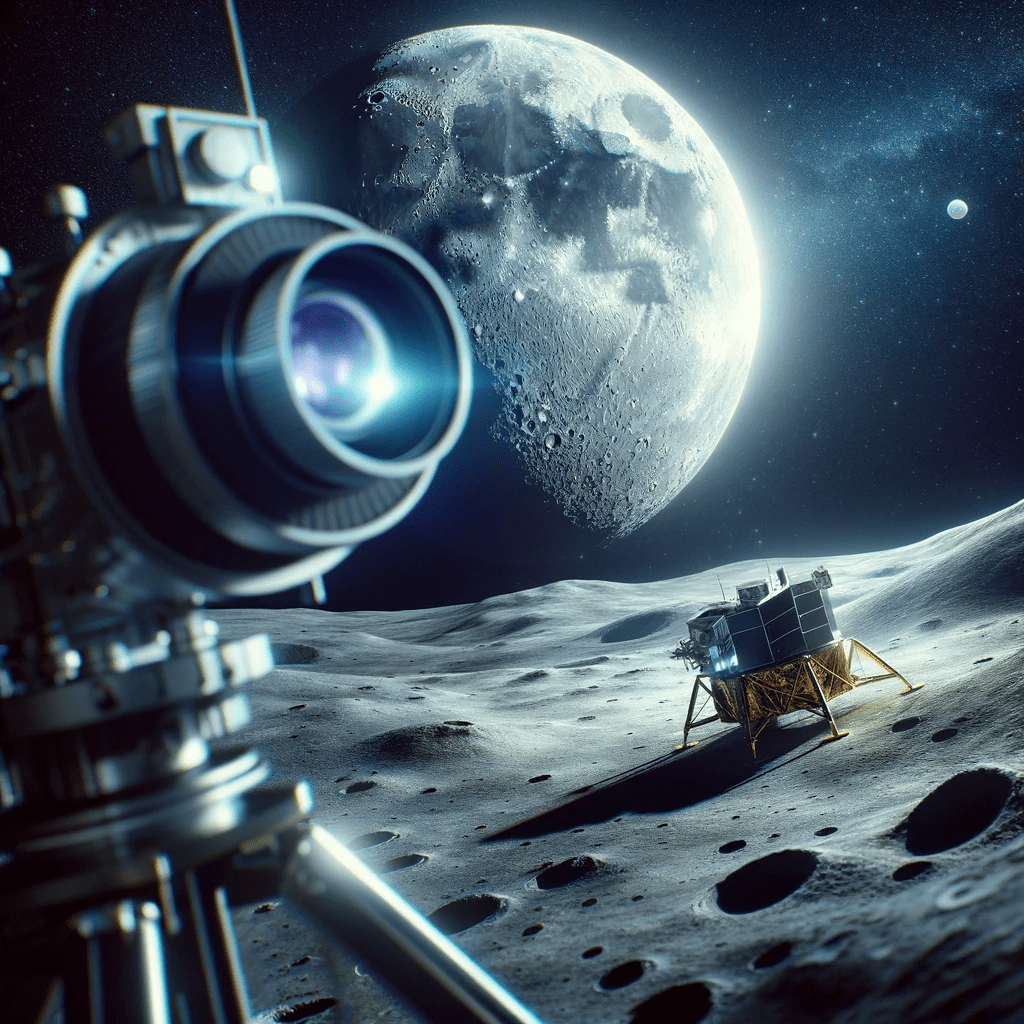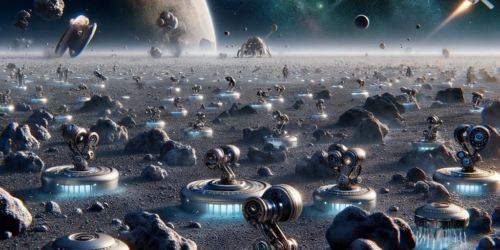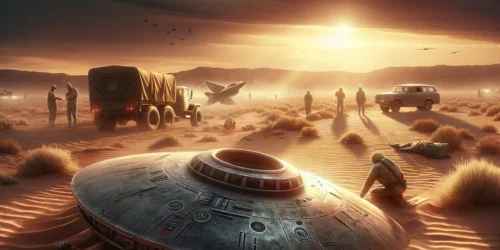What is Hiding on the Moon?

The Apollo missions, milestones in space exploration, achieved significant technological advances. Yet, a critical question arises: why, despite these advancements, do the images of the Moon captured by high-tech instruments like the Lunar Reconnaissance Orbiter (LRO) still face resolution limitations? This issue highlights a discrepancy between the progress in lunar exploration and the current state of lunar imagery. It raises concerns, particularly among amateur astronomers and enthusiasts, about the gap between expectations set by such advanced technology and the actual quality of lunar visuals available.
While mapping tools first introduced in 2006 hold great potential for lunar exploration, users express a longing for higher-resolution visuals that would unveil traces of human activity, including lunar buggies and the tracks they left behind. This desire for detailed, unaltered images reflects the aspiration to immerse oneself in the Moon’s surface as if physically present.
Considering the significant advancements made during the Apollo moon landings, why are there limitations in the resolution of images captured of the Moon? This gap highlights the contrast between the technological achievements of lunar exploration and the quality of lunar imagery available. Why?
The Apollo program, a monumental series of space missions conducted by NASA, marked an era of extraordinary achievements in space exploration and human spaceflight. This series of missions, particularly Apollo 11 through Apollo 17, with the exception of Apollo 13, represent significant milestones in our quest to explore the Moon. Each mission not only achieved remarkable feats in landing on and exploring different areas of the lunar surface but also contributed to a greater understanding of the Moon’s geology and our capabilities in space travel.
- Apollo 11: The historic first manned Moon landing occurred on July 20, 1969, with Neil Armstrong and Buzz Aldrin becoming the first and second humans, respectively, to step on the lunar surface. The landing site is known as the Sea of Tranquility (Mare Tranquillitatis).
- Apollo 12: The second manned Moon landing took place in the Ocean of Storms (Oceanus Procellarum) on November 19, 1969. Astronauts Charles Conrad and Alan Bean conducted two moonwalks during which they deployed scientific instruments and collected lunar samples.
- Apollo 14: This mission, which landed in the Fra Mauro highlands on February 5, 1971, was notable for the presence of Alan Shepard, who famously hit two golf balls on the Moon. Edgar Mitchell accompanied Shepard in the lunar EVA (extravehicular activity).
- Apollo 15: Marking the first of the “J missions,” which allowed for a longer stay on the Moon and greater scientific capability, Apollo 15 landed near Hadley Rille in the Apennine Mountains on July 30, 1971. David Scott and James Irwin conducted three EVAs, and this mission featured the first use of the Lunar Roving Vehicle.
- Apollo 16: On April 21, 1972, Apollo 16 landed in the Descartes Highlands. John Young and Charles Duke explored the area over three moonwalks, collecting samples and conducting experiments. This mission provided valuable geological insights into the Moon’s highlands.
- Apollo 17: The final Apollo lunar mission landed in the Taurus-Littrow valley on December 11, 1972. Eugene Cernan and Harrison Schmitt spent three days on the lunar surface, with Schmitt being the only geologist to walk on the Moon. This mission set records for the longest time spent in lunar orbit and the longest time spent on the surface.
There are a number of advantages of lunar orbiting and photography due to the Moon’s distinct characteristics. Its lower gravity and lack of atmosphere eliminate atmospheric interference, enhancing the feasibility of high resolution lunar photography.
The surface area of the Earth is larger than that of the Moon by a significant margin. To put it into perspective, Earth boasts an extensive surface area of approximately 510.1 million square kilometers, while the Moon’s surface is comparably modest at about 37.9 million square kilometers. When it comes to orbiting these two celestial bodies, the required speed depends on the altitude and type of orbit. For Earth, a low Earth orbit typically requires a speed of around 28,000 kilometers per hour (about 17,500 miles per hour), while the Moon’s orbit demands a speed of approximately 3,600 kilometers per hour (about 2,237 miles per hour) for a low lunar orbit.
The Moon’s lower gravity demands significantly less energy to achieve and maintain orbit, reducing the need for extensive propellant and energy expenditure. Moreover, the absence of a substantial atmosphere on the Moon eliminates the drag effect that spacecraft encounter when entering Earth orbit, further simplifying the process. Additionally, the Moon’s smaller size and the lack of atmospheric interference make navigation and orbital insertion comparatively less complex compared to the intricate maneuvers required for Earth orbit.
When photographs are taken from a satellite orbiting around the Moon, they benefit from the same advantages in terms of clarity and detail as those taken on the Moon’s surface. The absence of an atmosphere around the Moon eliminates atmospheric turbulence and the associated distortion and blurring commonly seen in Earth-based images. Additionally, the uniform and stable lunar surface, free from atmospheric and environmental fluctuations, provides an ideal backdrop for high-resolution imaging. Even though these images are captured from a satellite in orbit, they can still offer exceptional clarity and detail, comparable to those taken on the lunar surface, thanks to the favorable conditions of the Moon’s environment for photography.
NASA’s official Twitter account dedicated to Earth’s Moon, @NASAMoon, recently shared a significant accomplishment. On January 19, 2024, NASA described and showcased its ability to pinpoint objects on the lunar surface from orbit by drawing a comparison to locating a small cookie in New York City while standing 62 miles away in central New Jersey. This impressive feat was demonstrated by tracking ISRO’s (Indian Space Research Organization) Vikram lander, which carried a NASA retroreflector and touched down on the Moon on August 23, 2023. A photograph captured by NASA’s Lunar Reconnaissance Orbiter (LRO) just four days later revealed the lander at the center of the image, its shadow distinct against a bright halo formed by the interaction of the rocket plume with the Moon’s fine-grained regolith. The image spans an area approximately 1 mile (1.7 kilometers) wide.
Why can’t NASA offer a higher-resolution image of the Vikram lander, akin to the level of detail seen when spotting a car on a driveway like we can for Earth?
The Moon QuickMap application, is an innovative creation of Applied Coherent Technology, tailored specifically for the team working with the Lunar Reconnaissance Orbiter Camera (LROC) at Arizona State University. This tool serves as a gateway to the extensive lunar data gathered by NASA’s Lunar Reconnaissance Orbiter (LRO) and other lunar missions.
The LROC itself is a pivotal component of the LRO mission, which NASA launched in June 2009. This orbiter was primarily designed to produce high-resolution maps of the lunar surface, significantly contributing to our understanding of the Moon’s terrain and geology. The LROC comprises a suite of cameras that capture high-definition images of the lunar surface, aiding scientists in creating detailed maps and studying the Moon’s topography and resources. Its data has been crucial for both scientific research and planning future lunar missions, including potential human landings. The question of public access to higher-resolution still remains.
The world of amateur astronomy has seen significant advancements in optics and imaging technology, allowing enthusiasts to capture stunningly high-resolution photos of the moon. For example, Bruce Swartz, known online as Bruce Sees All (@BruceSeesall), is a notable example in this community. In a recent video, Swartz discusses his observations and theories related to unidentified flying objects (UFOs) and unidentified aerial phenomena (UAPs).
In the video, Swartz reflects on his journey in creating his channel, which was initially not intended to focus on UFOs or to generate income. He shares his personal experiences, including a traumatic event after his father’s passing, which he believes opened portals and led to encounters with light beings and UFOs. Swartz is candid about his belief in extraterrestrial life and his experiences with these phenomena, stating that he feels contacted and is unafraid to speak openly about it.
He claims to observe and record UFOs regularly, asserting that these sightings are not limited to his local area but are connected to him personally. Swartz plans to conduct tests to demonstrate that he can summon these lights wherever he is, be it in Montreal, Ontario, or elsewhere.
Swartz’s current focus is on what he refers to as “Tycho crater” on the Moon, where he has identified various unusual structures and anomalies. He highlights the distinctiveness of these findings by presenting them from multiple angles and perspectives, offering a thorough visual exploration of the lunar surface. These structures, according to Swartz, are more prominently visible along the Terminator line – the division between lunar day and night. He explains that adjusting the exposure in this region helps to bring out more details of the features.
The episode features detailed views of three craters in the vicinity of what Swartz calls “Tycho crater.” He posits that these craters and their surrounding areas may contain artificial structures, such as cylindrical shapes and right angles, which he believes are not naturally formed. Swartz speculates on the potential purposes of these structures, suggesting they might be used for mining activities or as passageways for pipes and lines.
Swartz also discusses an intriguing feature he calls the “wishbone connection,” likening it to a sunken boat at the bottom of an ocean. He theorizes that this formation, together with other linear structures and a mysterious tower-like feature, could be part of a comprehensive network of connections spreading across the lunar surface. Swartz voices his belief that these discoveries are highly confidential and might eventually be removed from public access or knowledge.
Swartz emphasizes the significance of his work in revealing these lunar anomalies. Swartz’s passion for uncovering the secrets of the Moon and extraterrestrial phenomena is evident, and he promises to share more revealing content in future videos.
The ongoing effort to obtain high-resolution lunar images, juxtaposed with the achievements of the Apollo missions, points to a complex interplay of technological limitations and aspirations. Amateur astronomers, leveraging significant advancements in personal optics and imaging technology, express dissatisfaction with the current state of professional lunar imagery, questioning why the images from sophisticated equipment like the LRO are not more detailed.



